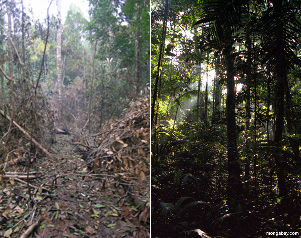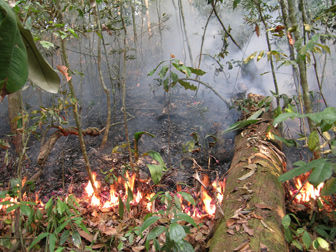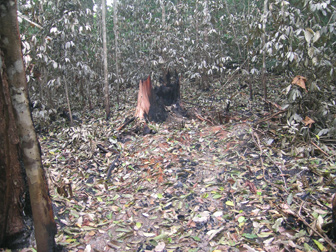Small fires a big threat to Amazon rainforest biodiversity
Small fires a big threat to Amazon rainforest biodiversity
Rhet A. Butler, mongabay.com
February 27, 2008
|
|
Small fires have a big impact in the Amazon rainforest, report researchers writing in Philosophical Transactions of the Royal Society B. The findings suggest a dire future for Earth’s largest rainforest.
Due to drying trends and fragmentation, surface fires are increasingly common in Amazon forests. Usually set by landowners clearing brush and vegetation, fires spread into surrounding forests areas, burning leaf litter and seedlings, especially during times of drought. The new research shows these knee-high fires cause significant changes in forest species composition.
“When a forest burns for the first time flame heights rarely exceed 30-40 cm, and the fire moves slowly through the leaf litter,” lead author Barlow, a researcher at Lancaster University, in the U.K. and Museu Paraense Emilio Goeldi in Brazil, told mongabay.com. “Although these fires appear relatively innocuous, they are actually very destructive as most rainforest trees have a low tolerance of heat, and their slow speed means that flames stay in contact with trees for long periods of time. As a result, even low-intensity fires kill up to 40 percent of trees. They are also the first step in positive feedback cycle, where the dead trees act to open up the canopy and add fuel to the forest floor, making the forest more flammable and increasing the severity of any additional fire.”
 On the left, low-intensity fires open up the canopy (photo by Jos Barlow). For comparison, primary Amazon rainforest on the right (photo by R. Butler). |
Sampling forests that had burned once, twice and three times in the last 20 years, Jos Barlow and Carlos A. Peres show that recurrent fires lead to an almost complete turnover in regenerating tree species.
“Almost none of the pioneer species that regenerated after low-intensity understory fires were able to survive a second burn, and the species that were most abundant in forests that had burned twice were replaced by a different suite of fast-growing species in forests that had burned three times,” he explained. “It appears that each fire event alters the seed bank and regeneration conditions and leads to a cascade in species composition, with forests becoming increasingly different from the species rich primary forests they once were.”
Carlos Peres, a professor at the University of East Anglia and a noted Amazon researcher, says that surface fires reduce tree diversity and the carbon-storing capacity of burned forests.
“Surface fires do not bode well for the future of lowland Amazonia. One of the most striking outcomes of recurrent fires over this 9-yr time series was the rapid deflection in the forest successional trajectories from a species-rich assemblage dominated by slow-growing heavy-wooded trees to a relatively depauparate set of fast-growing, soft-wooded species dominated by short-lived pioneers, and repeatedly burned primary forests were virtually indistinguishable from a young second-growth forest,” he said.
 Low-intensity wildfire
|
“This resulted in a dramatic erosion of species richness, functional diversity, aboveground phytomass and carbon stocks, which to us clearly represents a ‘lose-lose’ scenario. So, if our results from the lower Rio Tapajós basin bear any indication to future phase-shift ecosystem transitions in much larger areas of seasonally-dry Amazonian forests, then yes, we have every reason to be alarmed.”
With leading climate models forecasting a higher temperatures and lower precipitation for much of the Amazon by 2050, the changes suggest a troubling future for biodiversity in the region.
“The positive-feedback cycle that is set in motion when a forest burns once is much more damaging that previously thought, as each additional fire causes an almost complete turnover in the species composition of regenerating trees,” explained Barlow. “If our results from the Central Brazilian Amazon are typical of burned forests across Amazonia, then fires linked to anthropogenic land-use and climate change should be seen one of the greatest threats to the future integrity of the Amazonian Ecosystem.”
Jos Barlow and Carlos A. Peres (2008). Fire-mediated dieback and compositional
cascade in an Amazonian forest [FREE OPEN ACCESS]. Phil. Trans. R. Soc. B, DOI: 10.1098/rstb.2007.0026
